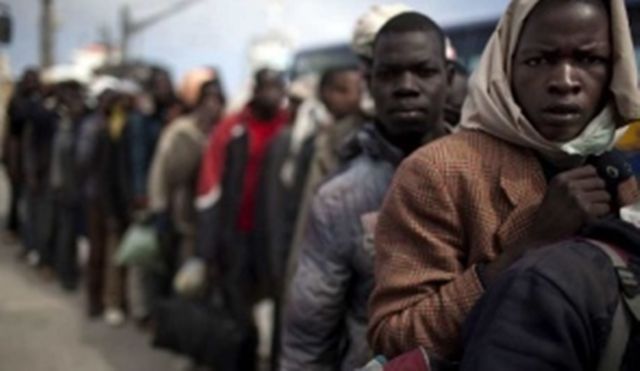
Europol Identifies Security Threat to Europe from North Africa’s “Arab Spring”
Publication: Terrorism Monitor Volume: 9 Issue: 19
By:

Without food, employment or security, thousands of sub-Saharan Africans are taking to the sea in overcrowded and unseaworthy boats in desperate attempts to escape the violence in Libya. They are joining some 25,000 Tunisians who have already fled to the Italian islands of Lampedusa and Linosa in hopes of gaining a foothold in Europe. Many boats have been lost in the Mediterranean crossing, at the cost of hundreds of lives (AP, May 9; EU Observer, May 3).
Last year, Mu’ammar Qaddafi struck a €50 billion deal with the European Union to regulate its borders as a “transit country” for refugees and economic migrants from Sub-Saharan Africa. Despite this payoff, Qaddafi has not hesitated to use it against Europe, threatening to “turn Europe black” if various demands are not satisfied (Der Spiegel, February 24). The French minister of foreign affairs, Laurent Wauquiez, has warned: “Libya is the funnel of Africa. Flows of illegal immigrants from countries such as Liberia, Somalia and Eritrea pass through Libya… We must defend our frontiers on a European level. What we’re talking about isn’t a few tens of thousands of illegal immigrants who could arrive in Europe; it’s a potential 200,000 to 300,000 this year” (Radio France Internationale, March 2).
Taking a quite traditional view on events in North Africa, the recently published annual Europol (European Law Enforcement Agency) report on terrorist and counter-terrorist activity in Europe concludes early on that “in the short term, the absence of terrorist organizations amongst the mass Arab protests across the region has left al-Qaeda struggling for a response.” For Europol, however, there is a danger in the longer term that if the expectations of those on the streets are not met, “it could result in more powerful terrorist organizations impacting the European Union.” [1] Paired with the current tensions between Italy and France over boatloads of North African migrants who arrived in Europe via Italy and then headed immediately for their linguistic homeland in France only to be stopped by police at the French border – something infringing the free movement of even those possessing only temporary papers within the Schengen zone in Europe – the threat posed by a potential overspill of the Arab Spring into Europe becomes evident. The report mentions this potential threat early on, highlighting that “the current and future flow of immigrants originating from North Africa could have an influence on the EU’s security situation” by offering an easy way for terrorists to slip onto the continent.
Events in North Africa are not, however, the only focus of the overall report and the main conclusions are, as usual, that separatist and left-wing terrorists are the most active in Europe. In total the report covers 249 attacks, with 160 considered separatist, 45 left-wing, three Islamist and one “single-issue.” Forty of the attacks were for “unspecified reasons” – all of these coming from the UK, which does not specify the ideological driver of British-based terrorist attacks.
The numbers in the annual Europol report are notoriously unreliable given the different ways in which member states classify terrorism and the growing variety of criminal legislation under which terrorists suspects are charged. Nonetheless, the report opens its key judgments with a statement that “the threat of attacks by Islamist terrorists in the EU remains high and diverse,” a blunt declaration that shows the priority European police forces continue to place on Islamist terrorism. [2]
In fact, based on the numbers in the report, it is far more likely that European citizens are going to come into contact with separatist terrorists – 349 suspects are reported to have been arrested in the past year. In the UK in particular, this has become increasingly obvious as Irish dissident groups become ever more deadly – in April, a car bomb in Omagh, Northern Ireland killed Roman Catholic policeman Ronan Kerr, an act believed to have been carried out by the Oglaigh na hEireann (ONH – Volunteers/Soldiers of Ireland), a splinter group of the Real IRA (Telegraph [London], April 3; BBC, April 3). ONH operatives are reported to have been under surveillance recently by the Special Reconnaissance Regiment (SRR) while scouting potential targets believed to be related to the 2010 London Olympics (Belfast Telegraph, April 21). Dissident Republican factions have returned to violence to protest the recruitment of growing numbers of Roman Catholics to the Police Service of Northern Ireland, the replacement for the formerly Protestant-dominated Royal Ulster Constabulary.
A few days after Kerr’s murder, a 500 lb truck bomb was found in Londonderry, and in the week before the royal wedding, the Real IRA paraded in a show of force through a cemetery in Londonderry. They concluded by delivering a speech in which they threatened police officers “regardless of their religion, cultural background or motivation,” as well as announcing that “the Queen of England is wanted for war crimes in Ireland and is not wanted on Irish soil” (BBC, April 25).
But even within the resurgent Irish militancy in the UK there are hints of the threat from North Africa. Those with a keen sense of history will recall that Colonel Qaddafi gave Irish dissidents large quantities of Semtex explosives and it was being investigated whether some of this might have been used to kill Constable Kerr. Defecting Libyan Foreign Minister Moussa Koussa is believed to have played a major role in supplying Republican terrorists with Semtex. Conservative MP Robert Halfon said: “If this is true then we must take every step to indict Mr. Koussa in the international war crimes courts or in the British courts for allegedly supplying the IRA with weapons which appear to have killed a policeman on Saturday” (Telegraph, April 3, 2011).
The EUROPOL report also touches upon the bigger strategic question that has been bothering experts about what the Arab Spring means for al-Qaeda’s global narrative. As the report puts it, developments in Tunisia and Egypt show that “peaceful demonstrations by ordinary people may be more effective than terrorist attacks” in effecting political change. However, the resulting “democratic space” could provide room for groups to “expand their activities,” using the “instability of state security forces” as an opportunity to launch attacks. The report notes the “clear contradiction to what al-Qaeda has insisted is the only means of defeating entrenched regimes is likely to result in a notable setback for terrorist organizations in terms of support and recruitment.” [3] So a short-term gain for terrorist groups may be overshadowed by a long-term loss.
This conclusion, however, is based on data prior to the descent of chaos on Libya. It is unclear to what degree that state might become a new jihadist battlefield that spills back into Europe like Algeria or Bosnia did in the 1990s, or like Iraq and Afghanistan more recently. The overriding nationalist flavor of the fighters in Libya and the continuing presence of the rich target of Qaddafi and his clique is likely to keep fighters busy for the immediate future, but in the longer term it is unclear what the implications of this might be for European security. The report highlights “ongoing concern” about “the number of predominantly young EU nationals travelling to conflict areas that include Afghan/Pakistani border, Somalia and Yemen with the intent to take part in armed combat,” it remains to be seen if Libya will soon need to also be added to this list.
Notes:
1. “TE-SAT 2011 – EU Terrorism Situation and Trend Report,” Europol, April 19, 2011: https://www.europol.europa.eu/publications/EU_Terrorism_Situation_and_Trend_Report_TE-SAT/TE-SAT2011.pdf.
2. Europol Report, p.6.
3. Europol Report, p.7.





